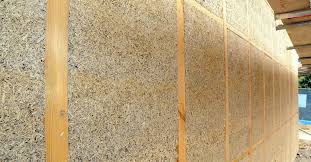
Hempcrete Insulation
Description:
Building Material Category: Insulation Products
Building Component Type: Wall and Roof
Alternative for Conventional Building Material: Traditional insulation materials like fiberglass and foam.
Introduction: Hempcrete is an innovative and sustainable building material made from hemp fibers and lime-based binders creating a lightweight, insulating composite material. It has been used historically in Europe and is gaining popularity in sustainable construction practices due to its environmental benefits and thermal performance. It is categorized as a biocomposite or sustainable insulation material used primarily for its thermal and acoustic insulation properties in building construction. It is not a structural material but is used in conjunction with structural elements to provide insulation. It serves as an alternative to traditional insulation materials like fiberglass, foam boards, and mineral wool. It offers eco-friendly and high-performance insulation without relying on synthetic materials.
Composition: It consists of a blend of hemp fibers, lime binder (usually hydraulic lime), and water, forming a lightweight, insulating material. Hemp Fibers/Shivs are the core ingredient, providing bulk and insulation properties. The lime binder includes hydrated lime or lime putty, which binds the hemp fibers and helps in curing and durability.
Applicability in Climatic Zone: Suitable for all climatic zones in India, offering effective insulation against both heat and cold.
Use: It is used primarily for insulating walls and roofs in residential, commercial, and industrial buildings, contributing to energy efficiency and comfort. It is often used in combination with other structural materials to create a highly insulated building envelope
Thermal Performance: It offers good thermal insulation, depending on the application thickness and mixture ratios of hemp fibers to lime binder, curing conditions (humidity and temperature).
Thermal Conductivity: It typically exhibits thermal conductivity values ranging from 0.05 to 0.08 W/mK, depending on the specific mixture and density. This is relatively low compared to conventional insulation materials, providing effective thermal insulation.
Thermal Transmittance: U-values for hempcrete insulation typically range from 0.05 to 0.08 W/m²K, indicating effective thermal resistance. The thermal transmittance (U-value) of hempcrete will depend on its thickness and density.
Reduction in CO2 Emissions: The use of hempcrete insulation can significantly reduce CO2 emissions, contributing to a more sustainable construction approach. Hempcrete is made from hemp fibers, which sequester carbon dioxide during the plant's growth phase. Typically, each hectare of hemp absorbs about 15 to 20 tonnes of CO2 during its growth cycle. When used in construction, this sequestered carbon remains locked in the hempcrete, effectively offsetting CO2 emissions over the building’s lifespan. Furthermore, the production of hempcrete is less energy-intensive compared to conventional insulation materials. For example, the embodied energy of hempcrete is approximately 60% lower than that of expanded polystyrene (EPS) insulation. This reduction in energy consumption during production translates to lower associated CO2 emissions. Additionally, hempcrete's excellent thermal performance reduces the need for heating and cooling, further cutting down energy use and related CO2 emissions. Overall, the use of hempcrete can lead to a reduction in carbon footprint by up to 30% compared to traditional building insulation materials, making it a significant contributor to lower greenhouse gas emissions in the construction industry.
Salient Features:
- Natural Insulation: Hempcrete provides effective thermal insulation, similar to conventional materials but with natural moisture regulation properties.
- Sustainability: It is made from renewable hemp fibers and lime binder, hempcrete is environmentally friendly and contributes to reduced carbon footprint in construction projects.
- Carbon Sequestration: Hempcrete absorbs CO2 during its growth and continues to sequester carbon dioxide over its lifespan, promoting carbon neutrality or negativity in building operations.
- Moisture Regulation: It posesses hygroscopic properties that regulate indoor humidity levels, preventing mold growth and enhancing indoor air quality.
- Fire Resistance: It is naturally fire-resistant due to its mineral content and charring rather than burning, hempcrete provides passive fire protection without the need for additional chemicals.
- Durability: It becomes stronger over time as the lime binder mineralizes, ensuring long-lasting performance and reducing maintenance requirements.
- Versatility: It is suitable for both insulation and structural applications, hempcrete simplifies construction processes and reduces the need for multiple building materials.
Indian Codes:
Hempcrete is an innovative and eco-friendly insulation material, but it lacks specific, dedicated codes in many regions. Instead, its use is guided by broader building codes and standards. Here’s a summary of relevant codes and standards for hempcrete insulation in India.
- IS 3346: Code of Practice for Thermal Insulation of Buildings
This standard covers general principles for thermal insulation in buildings but does not specifically address hempcrete. It provides guidelines that can be applied to various insulation materials, including hempcrete, in terms of performance and installation practices.
- IS 1442: Method of Testing for Thermal Insulation
This standard includes methods for evaluating the thermal performance of insulation materials. While it doesn’t specifically mention hempcrete, it provides relevant testing methodologies for assessing thermal conductivity and other properties.
International Codes:
- BS 5250: Code of Practice for Control of Condensation in Buildings
This UK standard provides guidelines on managing moisture and condensation in buildings, which is relevant for understanding the moisture-regulating properties of hempcrete.
- ISO 14001: Environmental Management Systems
This international standard addresses the broader environmental management practices that include the use of sustainable materials like hempcrete. It provides guidelines for minimizing environmental impact, including CO2 emissions reduction.
- ASTM Standards: Various ASTM standards may apply to the testing and performance evaluation of bio-based and natural building materials, including hempcrete. For instance, ASTM C518 for thermal conductivity and ASTM E84 for fire-resistance testing might be relevant.
- EN 16012: Thermal Insulating Products for Buildings – Vacuum Insulating Panels (VIPs)
While this European standard primarily addresses vacuum insulated panels, it represents the type of detailed standards that can be consulted for understanding performance testing and application in thermal insulation, which can be conceptually similar to standards needed for hempcrete.
Manufacturers:
- Hemp: https://www.gohemp.in/
Sources: